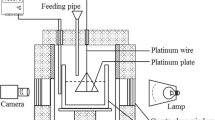Abstract
Aluminas having a wide range of physical characteristics were added in the laboratory to cryolite melts under different, controlled conditions of temperature and melt composition. Crusts were usually obtained, and their strengths, durability and solubility noted. It was shown that well-formed crusts are produced only by aluminas that are both sandy and relatively under-calcined. Such aluminas flow readily, and have a high surface area and a low α-alumina content. The mechanism of crusting is postulated as an initial cooling and freezing of the melt following penetration into alumina on the surface; a strong crust is a consequence of the subsequent growth of a network of α-alumina platelets. Aluminas initially of high α content do not form such a network. The difference between crusts formed by alumina additions and by simple freezing of a melt is considered. The effect of different aluminas on cell operation, as a consequence of their different crusting and solubility characteristics, is discussed.
Similar content being viewed by others
References
J. Thonstad, F. Nordmo, and J. B. Paulsen:Met. Trans., 1972, vol. 3, pp. 403–08.
I. S. Kachanovskaya, V. I. Osovik, and T. N. Kukhotkina:Tsvet. Met., 1971, vol. 44, no. 10, pp. 40–42.
Author information
Authors and Affiliations
Rights and permissions
About this article
Cite this article
Less, L.N. The crusting behavior of smelter aluminas. Metall Trans B 8, 219–225 (1977). https://doi.org/10.1007/BF02657650
Received:
Issue Date:
DOI: https://doi.org/10.1007/BF02657650




